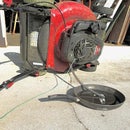Introduction: Refurbishing Drive Rollers for a NordicTrack Ski Machine
I have a NordicTrack Pro ski machine made in March 1994. The drive rollers on these machines begin to hiccup with a lot of use. That means the rollers may not grab immediately on the backward push stroke, or they may not release immediately at the beginning of the forward stroke. It is an easy problem to remedy at home. This Instructable will show you how.* All you need is a couple of wrenches, a screwdriver, some penetrating oil, and some facial tissue. The actual work requires only an hour or so, but you will need to allow the rollers to dry for a few hours.
*I published this information nine years ago in the Community Forums section of Instructables and over 40,000 people viewed it there. Quite a number commented that they were able to make their machine work like new again. But, the Community Forums will soon be phased out and content there will disappear. I am making it an Instructable.
Step 1: Mark the Rollers
I put a piece of masking tape on each drive roller and drew an arrow seen from above. The arrow indicates the front of the machine, and it will help be certain a roller is not installed backwards.
Step 2: Begin Removing the Sideboard
You will need to remove one of the two sideboards. I arbitrarily chose the left sideboard. Although I have a Pro model, this process is the same for most other models. I also did this procedure on the Challenger model we had previously. There are two Phillip’s head screws to the sides of the Pro emblem on the sideboard. Remove both.
Step 3: Remove Nuts From Sideboard Bolts
Four bolts hold the sideboard in place and make it part of the machine’s frame. Two are at the front and two are at the back. Two are visible from above after a ski has been removed from the machine. Two can be seen only from the underside of the machine. The first photo shows removing one of the nuts visible from above. The nut requires a 1/2 inch wrench. An open end or a box end work well. Unfortunately, I had to use different wrenches for other nuts because of space available. See the second and third photos. The fourth photo shows the sideboard removed. Notice the ball bearing for the flywheel shaft embedded in the sideboard. Remove the drive roller from the flywheel shaft. See the fifth photo. There are two washers on either side of the drive rollers. A plastic washer is next to the roller’s rubber surface. A steel washer is next to the plastic washer away from the roller. Make certain you can remember that, or consult the photo here.
Step 4: Remove the Other Roller
Wiggle the shaft out of the sideboard bearing on the side you did not remove. Pull the other drive roller off of the end of the shaft. Do not lose the washers. The spokes on the flywheel may be in the way. If so, rotate the flywheel and utilize the space between the spokes to wiggle more.
Step 5: Do Not Panic
Look closely at this roller. There is some obvious wear, but the heavy rubber tire never wears out. Your body weight will always ensure that the ski makes firm contact with the rubber.
Step 6: Clean the Bearing
These drive rollers sound very mysterious, but they use a common one-way needle bearing used for all sorts of applications in industry. Inside the bearing is a ramp system that provides grip in one direction and slack in the other. If your ski machine hiccups, the one-way needle bearings probably need only a little cleaning, not replacement. In time, fine metallic dust from metal rubbing on metal accumulates and makes the ramp grab and release system sluggish. Simply flush the bearings with a light penetrating oil, work them back and forth with your little finger, sop out any residue with a facial tissue, and allow to air dry before reassembly. You may need to flush each bearing several times until you can feel the one-way needle bearing moving freely. Also look at the tissue. Repeat this process until you no longer see gray residue on the tissue after sopping. (There are three individual bearings inside the drive roller. A one-way needle bearing is centered in the shaft hole. A bronze sleeve bearing is on either side of the one-way needle bearing.)
I have a can of Liquid Wrench I bought in the late-1960s. Some use WD-40, but a friend who rebuilds ski machines professionally strongly discourages that. He says a nasty residue can build up. Liquid Wrench is now sold as an aerosol, but it does the same job. Some similar products are also available.
The bronze sleeve bearings surrounding the one-way roller bearings are supposed to be oil impregnated and supply lubrication. If you wish, you may add a drop or two of ATF transmission fluid for lubrication.
In the third photo I rested the drive rollers on my wrenches to elevate them for better air circulation and drying.
I confess I find it difficult to stick to a consistent exercise routine. My ski machine does not get constant use. Still, flushing and drying the one-way roller bearings has restored their function on two ski machines with no problems for the machines. Try this simple home fix before you spend money ordering new drive rollers or sending your machine off for new rollers.
Bonus—Do you need a new electronic monitor on your ski machine to measure ground speed and exercise session duration? This is a link to making one for yourself from a digital bicycle speedometer commonly available wherever bicycles are sold.











